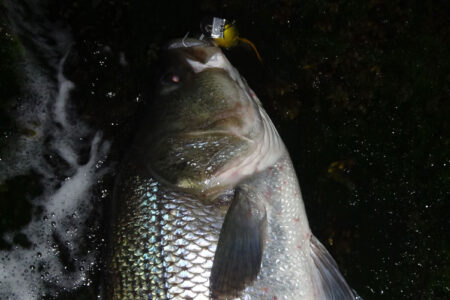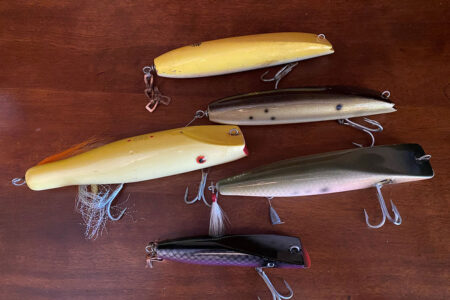
Everything you need to know about the pencil popper.
As far as the history of surfcasting is concerned, Stan Gibbs invented the Pencil Popper sometime in the late-1960s or 70s. I’m sure there is someone out there that knows the exact date, but this story isn’t about that. As a surfcaster and a plug builder, I feel like I can see how the idea germinated in Stan’s head and how it grew legs to become the surf staple that it is today. In my mental attempts to reverse-engineer the inspiration behind this plug, my mind runs to observations of baitfish being chased by striped bass. The fluid swimming, the frantic splashy wake and the ever-increasing speed as the singled-out baitfish literally runs for its life. That’s a look that would be next to impossible to replicate with a popper, metal lip or darter. It seems to me that Stan was a problem solver and he saw this as something that needed a solution.
We can never know how many other attempts he made at inventing a plug that could mimic this mode of baitfish panic, or maybe he nailed it on the first try… who knows? But, as simple as they are in appearance, there are some pretty ingenious details that make the pencil work the way it does.
It all begins with a light piece of wood, Gibbs pencils were (and most likely still are) made of pine and I’d guess the early ones were probably sugar pine, which is an expensive type of wood these days. The light wood means that the body of the plug will create less resistance meaning it will be more easily influenced by added weight, in other words, lighter wood maximizes the effects of the weight added to the plug. This way Stan could add weight wherever he saw fit and know that he would get the most action out of whatever changes he made.
Stan was also a master of natural momentum. His understanding of the center of gravity and how it could be affected by shape are what gave way to other classic Gibbs originals like the Bottle Plug and the Polaris Popper, those skinny necks forcing the natural center of gravity further back, resulting in a natural tendency to cast better. The elongated teardrop shape of the pencil popper is just another way to achieve this and that bulbous rear end would already want to carry the shape on the cast, add weight and it might transform into a rocket.
It seems to me that the weight was carefully added to the pencil, skinny, tubes of lead are fitted around the through wire and situated right against the rear end of the plug. He could have stacked all that weight right there at the back end, but he spread it out, extending about a third of the length of plug, this would serve to reduce the pivoting action – just enough – to make it look fluid and alive. The hooks were also carefully placed so that their weight would only accentuate the placement of the lead. The last flourish is that gently cupped face, this gives the plug a more finished look, but also spits water forward, like a tiny popper mouth.
There are many ways to work a pencil popper. I prefer to work them slowly and deliberately, because this gives me the option to speed up when a fish shows interest in the plug. However, another effective method is to grab your rod and line just below the first guide and use that hand to get the tip if your rod bouncing wildly. This sets the pencil into a frantic froth, the goal with your cranking hand is to barely advance the plug at all – keeping this freaked-out popper headbanging as along as possible in the strike zone. Both methods catch fish and it’s wise to keep both methods in good practice because – as with most plugs – there isn’t just one correct way to work a pencil popper.
Pencils excel in a wide array of situations; any topwater situation where a long cast is needed, heavy surf, heavy current, hard wind or even on a flat-calm day with the slightest wind riffle, pencils will draw strikes. They are also a rare design that works pretty much the same whether you’re using a litter 1-ouncer or a beast weighing upwards of 5 ounces (provided they are well built). This means they are staples for all species of baitfish from silversides to mullet to mackerel to adult bunker. If you’re not using them, you are definitely missing out!



